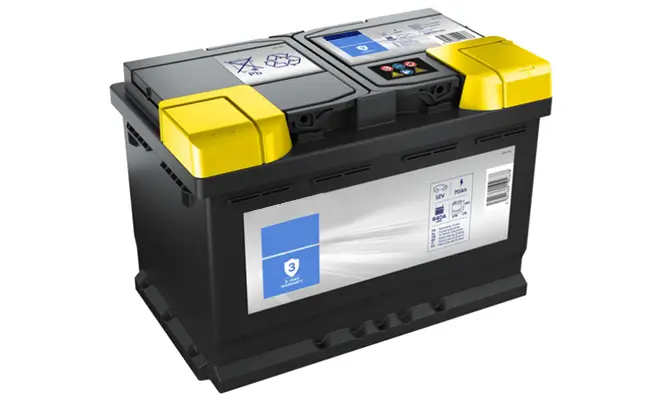Your vehicle's battery is crucial to its proper operation. When it begins to show signs of weakness—due to age, temperature drops, or a charging system fault—it is not uncommon to see the battery warning light illuminate on the dashboard. In such cases, replacement may be unavoidable.
What type of battery should you choose?
How can you be sure it's compatible with your vehicle?
Should you stick with the same technology?


Are you looking for a car scanner ?
How to Choose the Right Car Battery
The battery is a key component for your vehicle's operation. It powers the engine's start-up, supplies energy to electronic systems, and enhances driving comfort. Yet with so many battery technologies available on the market, identifying the right fit isn't always simple.
Whether for standard, modern, or electrified vehicles, there are several battery technologies designed to meet performance, durability, and compatibility requirements.
This article introduces the main types of automotive batteries, their technical specifications, pros and cons, and typical use cases.

Why Does the Warning Light Come On?
The AdBlue warning light may illuminate for various reasons. Identifying the cause is the first step in resolving the issue.
First, if the light is flashing or steady, it’s likely that your AdBlue tank is nearly empty.
If the tank is full but the warning light remains on—or if the engine warning light is also illuminated—it may indicate a more serious issue affecting the vehicle’s emissions control system.
What Are the Different Battery Types?
Conventional Lead-Acid Battery
Technical Specifications
Still widely used, conventional lead-acid batteries are designed to deliver a strong current burst to start the engine. Their depth of discharge (DoD) should not exceed 50% of their total charge.
In diesel vehicles, these batteries are generally larger than those used in petrol engines due to higher Cold Cranking Amps (CCA) required.
Advantages
- Suitable for vehicles without complex electronics
Disadvantages
- Sensitive to charge/discharge cycles
- Limited lifespan
- Requires regular maintenance
Applications
Best for older vehicles or light-duty applications such as lawn mowers, small engines, or devices with low and occasional power needs.

Are you looking for a car scanner ?
AGM Battery (Absorbent Glass Mat)
Technical Specifications
AGM batteries use fiberglass separators to absorb the electrolyte, making them more stable and resistant to vibration. This design allows high power output for advanced systems like start-stop. The average DoD is around 80%.
Two configurations exist:
- Flat AGM: Standard for vehicles with start-stop and regenerative braking.
- Spiral AGM: Uses rolled plates to improve compactness, performance, and vibration resistance—ideal for off-road vehicles and heavy equipment.
Advantages
- Excellent durability
- Handles deep cycles well
- Fast recharge
Disadvantages
- Not compatible with all vehicles (requires specific alternator)
Applications
Ideal for modern vehicles with start-stop systems and heavy electrical loads or demanding usage conditions.
EFB Battery (Enhanced Flooded Battery)
Technical Specifications
EFBs are improved lead-acid batteries with reinforced internal plates to handle frequent charge/discharge cycles typical in simple start-stop systems. They perform better under stress than conventional lead-acid batteries.
Advantages
- Better suited for frequent start cycles than standard lead-acid batteries
Disadvantages
- Lower performance than AGM batteries
- Sensitive to extreme temperatures
Applications
Mainly for city cars and compact sedans with basic start-stop systems (first generation).
GEL Battery
Technical Specifications
GEL batteries (also called VRLA) use a gelified electrolyte instead of liquid acid, making them fully sealed and safer against leaks or vibrations.
Advantages
- Fully sealed
- High tolerance to deep discharge
- Very long service life
Disadvantages
- Lower performance in cold temperatures
- Longer charging time
Applications
Best for seasonal or low-use vehicles (motorhomes, boats, leisure vehicles) or harsh environments (emergency vehicles).
Lithium-Ion Battery
Technical Specifications
Primarily used in electric and plug-in hybrid vehicles, lithium-ion batteries offer high energy density, lower weight, and extended life. However, they are not suitable for traditional combustion-engine vehicles.
Advantages
- Extremely lightweight
- Long lifespan
- Quick charging
Disadvantages
- Very expensive
- Incompatible with vehicles not designed for this technology
Applications
Reserved for electric or plug-in hybrid vehicles specifically built to support lithium-ion batteries.
Battery Type Comparison
| Category | Maintenance Required | Lifespan | Cost | Recommended Usage |
|---|---|---|---|---|
| Standard Lead-Acid | Yes | 3–5 years | € | Standard combustion-engine vehicles |
| Flat AGM | No | 4–6 years | €€€ | Vehicles with start-stop systems |
| Spiral AGM | No | 5–8 years | €€€ | Heavy-duty electrical load or harsh conditions |
| EFB | No | 3–5 years | €€ | City and compact cars with basic start-stop |
| GEL | No | 6–9 years | €€€ | Stationary or infrequently used leisure vehicles |
| Lithium-Ion | No | 8–15 years | €€€€ | Electric or plug-in hybrid vehicles |
Notes:
- Lifespans are indicative and depend on battery quality, climate, charge cycles, and charging system performance.
- Frequent starts and extreme temperatures shorten battery life.
- “Maintenance-free” batteries are sealed but should be checked regularly via voltage testing.
- Open lead-acid batteries require regular electrolyte checks.
What to Consider Before Buying a Battery?

Before purchasing, be sure to check:
- Vehicle compatibility
- Check your vehicle owner's manual
- Keep the same technology as originally equipped (especially for AGM or lithium-ion)
- Technical specifications
- Capacity (Ah): battery autonomy
- Cold Cranking Amps (CCA): cold start capability
- Nominal voltage: 12V (passenger cars) or 24V (commercial vehicles)
- Dimensions and polarity
- Respect size constraints: Batteries often sit in a specific housing; a mismatch can cause fitting or stability issues.
- Check terminal positions (positive and negative)
- Designation standards
- EN: European standard
- SAE: American standard
- JIS: Japanese standard
- DIN: German standard
Batteries are identified by different industry standards:
Each standard specifies formats for capacity, CCA, and terminal layout.
Learn More
That's it for this article on the different types of car batteries. If you have tips or questions, feel free to share them in the comments section below.
You can also share this article with your friends on social media!

